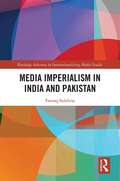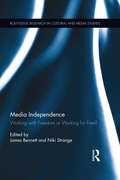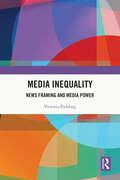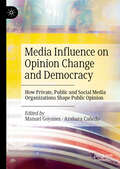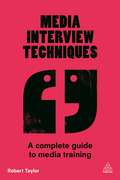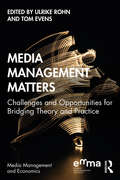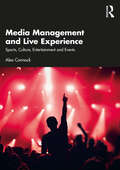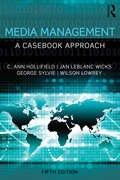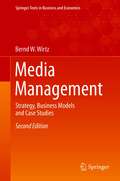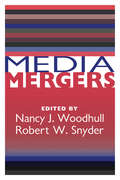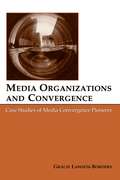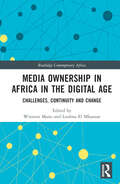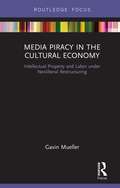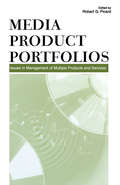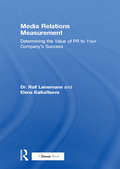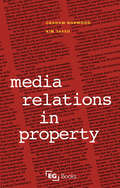- Table View
- List View
Media Imperialism in India and Pakistan (Routledge Advances in Internationalizing Media Studies)
by Farooq SulehriaExamining anew the notions of media imperialism and globalization of media, this book disrupts the generalised consensus in media scholarship that globalization of media has put an end to media imperialism. One elemental aspect of media imperialism is the structural dependency of television systems in the global South on the imperial North. Taking India and Pakistan as its case studies, this book views globalization of media as the unleashing of processes that have translated into the liberalization of air waves and privatization of television systems whereby commercialization of television is privileged over public interest television. Additionally, it argues that the globalization of media has contributed to corruption, tabloidization, and marginalization of subaltern classes in the Indian and Pakistani media.
Media Independence: Working with Freedom or Working for Free? (Routledge Research in Cultural and Media Studies)
by James Bennett Niki StrangeMedia independence is central to the organization, make-up, working practices and output of media systems across the globe. Often stemming from western notions of individual and political freedoms, independence has informed the development of media across a range of platforms: from the freedom of the press as the "fourth estate" and the rise of Hollywood’s Independent studios and Independent television in Britain, through to the importance of "Indy" labels in music and gaming and the increasing importance of independence of voice in citizen journalism. Media independence for many, therefore, has come to mean working with freedom: from state control or interference, from monopoly, from market forces, as well as freedom to report, comment, create and document without fear of persecution. However, far from a stable concept that informs all media systems, the notion of media independence has long been contested, forming a crucial tension point in the regulation, shape, size and role of the media around the globe. Contributors including David Hesmondhalgh, Gholam Khiabany, José van Dijck, Hector Postigo, Anthony Fung, Stuart Allan and Geoff King demonstrate how the notion of independence has remained paramount, but contested, in ideals of what the media is for, how it should be regulated, what it should produce and what working within it should be like. They address questions of economics, labor relations, production cultures, ideologies and social functions.
Media Inequality: News Framing and Media Power (ISSN)
by Victoria FieldingNews media notionally underpins a vibrant and diverse democracy by representing political, industrial and social conflict to mass audiences. Yet, few studies measure how equitably journalists frame public contestation. Despite framing theory’s extensive use in media and communication scholarship, little is known about how frames are created and disseminated - how frames are built - to explain how and why journalists frame news the way they do.Media Inequality proposes that frame building occurs through a two-step process of frame adoption and replication. This two-step frame-building process is explored by identifying the newspaper master narratives used in five historical industrial dispute case studies. These master narratives are then mapped to public narratives used by unionised firefighters and their employer in the Australian case of the 2016 Victorian Country Fire Authority industrial dispute. By theorising about the causes of journalists’ inequitable framing of contested narratives, Media Inequality tells the story of unconscious structural media bias, interrogates the power of news media to reinforce dominant frames, offers valuable theoretical perspectives about the influence of media power on the accumulation of power in society, and provides lessons for groups communicating in competitive contexts.Media Inequality is thus valuable to scholars, academics and research students in the fields of journalism, communication, and media, particularly scholars interested in how journalists represent political, industrial, and social contestation.
Media Influence on Opinion Change and Democracy: How Private, Public and Social Media Organizations Shape Public Opinion
by Manuel Goyanes Azahara CañedoThis book reviews and advances the theoretical and empirical knowledge at the intersection of opinion change and democracy. Specifically, the volume addresses how opinion change and political persuasion unfold in three main domains of media effects: private media (i.e., news organizations), public service media (state-own media services), and social media platforms. Divided in these three different sections, the volume serves as a venue to discuss and further advance the most recent theoretical assumptions and empirical findings that underpin our current understanding on how media influence public opinion and shape liberal democracies. The book also explores how media literacy and critical thinking can mitigate the effects of misinformation and propaganda, emphasizing the importance of educating the public to discern credible information from deceptive content. Furthermore, it discusses the ethical implications of media practices and the responsibilities of media producers in maintaining the integrity of democratic discourse. By highlighting these aspects, the book provides a comprehensive understanding of the complex interplay between media, public opinion, and democracy, offering valuable insights for scholars, policymakers, and anyone interested in the role of media in shaping public opinion.
Media Interview Techniques
by Robert TaylorAny individual preparing for an interview with the media, however practised or well-rehearsed they are, understandably feels a sense of trepidation over failing to convey the essential points, or encountering that awkward question in the glare of public scrutiny. As media channels multiply by the day, offering ever more opportunities for exposure, so they also present a growing probability of finding oneself in front of the camera, webcam, or microphone in a make-or-break encounter where every word, gesture or expression counts. Never has media training been more relevant, or more in demand. Media Interview Techniques is the authoritative guide to giving successful media interviews, combining the author's own unique models and techniques with a survey of published research and influential opinion to help you prepare for that occasion when you are called upon to represent your organization publicly. Supported throughout with insightful anecdotes and transcripts of good and bad interviews given by George W. Bush, Prince Philip and other notable figures, this book presents the author's methodology which has been proven across the spectrum of industry sectors both nationally and internationally, and will apply whether you are speaking for a commercial company, a charity or NGO, public services or as a subject expert. No PR executive or press officer can afford to be without a copy for briefing clients prior to an interview.
Media Management Matters: Challenges and Opportunities for Bridging Theory and Practice (Media Management and Economics Series)
by Tom Evens Ulrike RohnThis edited volume explores media management as engaged scholarship, building a bridge between theory and practice and discussing research collaboration between academia, policymakers and the media industry. In addition to advancing the scholarly discipline, it also questions, investigates and discusses the practical value of the research undertaken, showing how media management research can provide actionable, practice-relevant knowledge to decision makers throughout the media industry. The volume is broken into two parts: a section reflecting on the need for collaboration between research and practice, and a section overviewing specific projects that aim to deliver administrative value to stakeholders. The international research projects presented here span topics such as digital transformation, business models in news and digital journalism, media entrepreneurship and start-ups, ad-blocking, location-based services, audiovisual consumption preferences, the sustainability of small television markets, co-located and clustered industries and digital privacy. Incorporating under-used methodological approaches, such as action research and ethnography, Media Management Matters brings suggestions for how scholarship might be promoted outside academia. Simply put, this book aims to demonstrate why media management matters. Featuring an international roster of contributors, this collection is essential reading for scholars and practitioners of media management, business and policy.
Media Management and Artificial Intelligence: Understanding Media Business Models in the Digital Age
by Alex ConnockThis cutting-edge textbook examines contemporary media business models in the context of Artificial Intelligence (AI) and digital transformation. AI has dramatically impacted media production and distribution, from recommendation engines to synthetic humans, from video-to-text tools to natural language models. "AI is really the change agent of the media industry," answered a natural language generation model when AI was ‘asked’ about the subject of this book. "It will open incredible opportunities." This book seeks to explore them. The media is examined through four sections. ‘Principles’ maps business models and the key tools of AI. ‘Platforms’ covers distribution channels in Games, Streamers, Social Networks, Broadcast and Digital Publishing. ‘Producers’ covers the engines of content-making, including Scripted, Entertainment, Factual, Content Marketing, Creators and Music. Finally, ‘Pioneers’ covers emerging sectors of Podcasting, Esports, the Metaverse and other AI-driven developments. Then in each chapter, a standard value creation model is applied, mapping a single sector through development, production, distribution and monetisation. Diverse case studies are analysed from India, Nigeria, South Korea, South Africa, France, the Netherlands, the US, the UK, Denmark and China – around creative entrepreneurship, revenue models, profit drivers, rights and emerging AI tools. Questions are provided for each case, whilst chapter summaries cement learning. Applied and technology-focused, this text offers core reading for advanced undergraduate and postgraduates studying Media Management – or the relationship between Entertainment, Media and Technology. Online resources include chapter-by-chapter PowerPoint slides and an Instructor’s Manual with further exercises and case studies.
Media Management and Digital Transformation
by Stewart Clegg Arne L. Bygdås Aina Landsverk HagenMedia Management and Digital Transformation provides novel and empirically rich insights into the tensions, struggles and innovations of news making and managing in media organizations. <P><P> From an empirically grounded perspective this book investigates how the 'buzz' of new technology tends to prevent management from seeing which changes are needed and indeed possible to make in the newsroom. It presents ground-breaking research showing that fostering ingenious, innovative solutions can be created from within organizations by engaging and allowing employees to recognize problems, reflect and experiment with new ways of working, using technology as support for change. The research presented arises from a four-year action research project in collaboration with three small and medium-sized Norwegian newspapers, in addition to ethnographic research in newsrooms and on media organizations and phenomena in the USA and Europe. It includes among other empirical examples of newsrooms transitioning from a deadline-controlled workflow to an open-ended flowline production, and provides new tools and methods for fostering collaborative creativity and co-creative innovation practices. It also looks into newsrooms’ attempts to strengthen their audience engagement, metrics performance and external collaborations with technology providers, journalism education and action researchers. <P><P> With theoretical chapters, methodological insights and qualitative case studies of contemporary practices, this book is essential reading for students and practitioners involved with media management globally.
Media Management and Live Experience: Sports, Culture, Entertainment and Events
by Alex ConnockGlobal and authoritative, this textbook maps modern, live experience media, the categories that thrive on real-time engagement and human connection – even in the age of synthetic content, AI and the Metaverse. Sports and sports betting, festivals, comedy, concerts, tours and theme parks are covered – plus theatre, trade events, conventions, museums and galleries, and immersive media.Live media events included are Burning Man, Glastonbury, the Indian Premier League, the English Premier League, Olympics, NBA and Bundesliga – plus sell-out Taylor Swift tours, the World Cup, Super Bowl, Ryder Cup and Formula One. Business models in this media category start with ticketing and advertising – now amplified with ecommerce, affiliate marketing, subscription and gambling transactions. Deep dives ask: Why is Saudi Arabia investing billions into golf and football? Why is standup comedy big in Nigeria? How are Broadway and the West End evolving? What do immersive technologies like Abba Voyage and the MSG Sphere offer for the future?With class questions, a quiz, summaries and slides for each chapter, this is a guide and course structure for anyone at university level or in industry studying the media, music, entertainment, events, exhibitions, sports, social media or gambling industries.
Media Management: A Casebook Approach
by George Sylvie C. Ann Hollifield Leblanc Jan Wicks Stephen Lacy Broadrick Ardyth SohnMedia Management: A Casebook Approach provides a detailed look at the major areas of responsibility that fall to the managers of media organizations, including leadership, motivation, planning, marketing, and strategic management. It provides media-based cases that promote the development of critical thinking and problem-solving skills. Addressing such topics as diversity, group cultures, progressive discipline, training, and market-driven journalism, this casebook provides real-world scenarios that help students anticipate and prepare for experiences in their future careers. Among the additions to this fourth edition are Increased discussions on groups, vision, change, diversity, and management styles; Additional media-sensitive examples within each section of the text; A new chapter on knowledge management; Ethics integrated into law and leadership discussions; A primer in global markets, technology, and policy; In-depth consideration into the aspects of change; and Increased emphasis on analysis. This edition also includes management scenarios in which one or more participant is a new employee or intern, making the material relevant to students while also preparing them to understand the motivations of their future employers. Developed as a media management text for advanced undergraduates and graduate students, Media Management provides realistic scenarios and invaluable insights on working in the media industries.
Media Management: A Casebook Approach (Lea’s Communication Series)
by George Sylvie C. Ann Hollifield Wilson Lowrey Jan Leblanc WicksMedia Management: A Casebook Approach provides a detailed consideration of the manager's role in today's media organizations, highlighting critical skills and responsibilities. Using media-based cases that promote critical thinking and problem-solving, this text addresses topics of key concern to managers: diversity, group cultures, progressive discipline, training, and market-driven journalism, among others. The cases provide real-world scenarios to help students anticipate and prepare for experiences in their future careers. Accounting for major changes in the media landscape that have affected every media industry, this Fifth Edition actively engages these changes in both discussion and cases. The text considers the need for managers to constantly adapt, obtain quality information, and be entrepreneurial and flexible in the face of new situations and technologies that cannot be predicted and change rapidly in national and international settings. As a resource for students and young professionals working in media industries, Media Management offers essential insights and guidance for succeeding in contemporary media management roles.
Media Management: Strategy, Business Models and Case Studies (Springer Texts in Business and Economics)
by Bernd W. Wirtz“Digitalization significantly changes the media. To cope with this change and to exploit new market opportunities is a major challenge for media corporations. Bernd Wirtz provides a valuable guideline for this new world, combining theory, facts, and practice.” Dr. Hubert Burda, German publisher and Managing Corporate Partner of Hubert Burda Media Holding KG “The media business is subject to substantial change while differences between distinctive media areas are fading away. This is due to technical innovation in areas like transmittance of content, bearer of content and recording devices but also due to new formats, trends and constant change of consumer behavior.” The textbook “Media and Internet Management” stays abreast of changes and covers this topic on a well-founded and comprehensive basis. It makes a valuable contribution to theory and practice in media management and is highly recommendable to media managers.” Christoph Mohn, Chairman of the Supervisory Board, Bertelsmann AG “The world of media is full of challenges and dynamic conditions for its field. The dynamic of this market is accelerated even more by new digital technologies and ongoing globalization. This book is an absolute “must have” for everyone who wants to know more about the basics, conditions and requirements of modern media management. The analytical clearness and structure make this publication highly relevant for students, but also for managers.” Urs Rohner, Chairman of the Board of Directors, Credit Suisse Group AG “Media Management is a textbook, but a very welcome newcomer for students and teachers as it fills a market gap for good educational material in this rapidly evolving field. It is concise, simple (but not simplistic), and contains a contemporary overview of concepts and tools for media managers. ” Prof. Dr. Bozena I. Mierzejewska, Editor of The International Journal on Media Management, Fordham University, New York “Summed up, with his second edition Wirtz managed to strengthen the outstanding position of his publication “Media Management”. His textbook shines because of its content, analytical clearness and the high relevance for business practice without losing its academic background. With the second edition this book has established its position in the field of media business as the leading standard reference book in Germany. It is suitable for business students, lectures as well as managers who can gain magnificent information from it.” Prof. Dr. Wolfgang Fritz, Director of the Institute of Marketing, Braunschweig University of Technology, Germany; Honorary Professor at the Institute of Business Administration, University of Vienna, Austria.
Media Markets Down South: Goldman Sachs' Investment in Grupo Clar n
by Rafael Di Tella Jose Liberti Sarah McAraFounded in 1945, Grupo Clar n expanded over several decades to become Argentina's largest media conglomerate. With leading positions in newspapers, broadcast television, broadcast radio, cable television, and Internet services, Grupo Clar n caught the attention of U.S.-based investment bank Goldman Sachs, which acquired an 18% share of Grupo Clar n for US$500 million in 1999. While Grupo Clar n struggled during the economic crisis from 2001 to 2002, it was well positioned to grow as the economy began to recover in 2003, in part due to government policies that helped stabilize the media industry. Now in October 2007, Grupo Clar n was preparing to make an IPO in London and Buenos Aires, and fund managers at Goldman Sachs were reevaluating their position. What price would the IPO reach and how much, if any, of their stake should they sell? What was the return Goldman Sachs would obtain if they sold its entire position, or just one part?
Media Markets Down South: Goldman Sachs' Investment in Grupo Clar n
by Rafael Di Tella Jose Liberti Sarah McAraFounded in 1945, Grupo Clar n expanded over several decades to become Argentina's largest media conglomerate. With leading positions in newspapers, broadcast television, broadcast radio, cable television, and Internet services, Grupo Clar n caught the attention of U.S.-based investment bank Goldman Sachs, which acquired an 18% share of Grupo Clar n for US$500 million in 1999. While Grupo Clar n struggled during the economic crisis from 2001 to 2002, it was well positioned to grow as the economy began to recover in 2003, in part due to government policies that helped stabilize the media industry. Now in October 2007, Grupo Clar n was preparing to make an IPO in London and Buenos Aires, and fund managers at Goldman Sachs were reevaluating their position. What price would the IPO reach and how much, if any, of their stake should they sell? What was the return Goldman Sachs would obtain if they sold its entire position, or just one part?
Media Mergers
by Nancy J. Woodhull Robert W SnyderThe recent surge in media mergers has set off a wave of stories that all hit very close to home. In some cases, the news organizations themselves become news. The formation of communication conglomerates raises profound questions for reporters' lives and work, such as: What is the best way to cover stories of high profile and complexity? Will the new giants broaden both the definition of journalism and the opportunities for journalists to practice their craft? What are the prospects for the new partnership of big news, new media, and big business? The consequences of consolidation vary by media industry. The evolution of communication technology is so fast that today's truisms can be undone tomorrow. Media Mergers provides a healthy dose of skepticism, a search for illuminating facts, and a willingness to consider all sides of the discussion.This book approaches the emergence of media giants from a variety of angles. The contributors offer many ways of understanding their scale and their significance. Media Mergers is divided into six parts: "Point/Counterpoint," "The Imperial Moment," "Captains of Communication," "States of Media," "The Consequences of Media Empires in the United States," and "The Consequences of Media Empires Around the World." Authors include: Todd Gitlin; Steven Rattner; Ken Auletta; Madeline Rogers; Danny Schechter; Barbara Maltby; and Mac Margolis.Included in this volume is a roundtable introduced by Walter Cronkite and moderated by Alex Jones. Participants are Frank A. Bennack, Jr., Neil S. Braun, P. Anthony Ridder, and Arthur Ochs Sulzberger, Jr. A review essay by Anne Wells Branscomb concludes book. She discusses various books on the subjects of media moguls, multimedia conglomerates, and media takeovers. Media Mergers is especially pertinent today, an age in which the communications industry is constantly changing, progressing, and being affected by business upheavals. It will be of interest to publishers, media specialists, and all those in communications, policy and research.
Media Moguls (Communication and Society)
by Michael Palmer Jeremy TunstallThe emergence of a few powerful individuals in control of large sections of mass communication industries has coincided with world-wide media de-regulation. In the first book to take a close look at media moguls as a species, Jeremy Tunstall and Michael Palmer show how a handful of own-and-operate entrepreneurs run their empires with a highly eccentric and highly political management style. Individuals such as Berlusconi, Hersant, and Murdoch, in France, Germany, Italy, Britain and the US, are considered in the context of the changing European media industry. The book considers other, non-mogul trends: the emergence of a European media policy and a European-US-Japanese world media industry. Additional case studies focus on Reuters as a news-and-data super-agency and the part played by advertising and other media lobbies in shaping media policy.
Media Organizations and Convergence: Case Studies of Media Convergence Pioneers (Routledge Communication Series)
by Gracie L. Lawson-BordersThis volume offers a timely examination of technology's impact on media companies and the results of convergence among media industries, considering the effects on journalistic, business, and economic practices. Media Organizations and Convergence: Case Studies of Media Convergence Pioneers considers the many definitions of convergence and explores the changes in communication technologies. Author Gracie L. Lawson-Borders provides a brief history of media segments and their evolutions as they adapt to emerging technologies, media conglomeration, and the competitive and global changes that have occurred in the industry. She also examines the theoretical implications of technology and convergence in the operations and practices of media organizations.The case studies included here profile three media convergence pioneers--Tribune Company in Chicago, Media General in Richmond, and Belo Corporation in Dallas--that have incorporated convergence into their journalistic practices. Lawson-Borders considers the social, cultural, and political implications of convergence, and presents issues and concerns for the future of convergence in the media industry.As a snapshot of media convergence at the current stage in its evolution, this book offers important insights into the business of media at a time of dramatic change. It will be a valuable resource for scholars and students in media management, mass media, and related areas of the media industry.
Media Ownership in Africa in the Digital Age: Challenges, Continuity and Change (Routledge Contemporary Africa)
by Winston Mano Loubna El MkaouarWho owns the media and communications in Africa today and with what implications? The book elegantly answers this urgent question by unpacking multiple dimensions of media ownership through rare and authoritative perspectives, including both historical and contemporary digital developments. It traces the evolving forms of ownership of media and communications in specific African contexts, showing how they interact with broader changes in and outside the continent. The book also shows how Big Techs, such as Meta (formerly known as Facebook), are involved in a scramble for Africa’s digital ecosystem and how their advance brings both opportunities and concerns about ownership and control. The chapters analyse evolving forms of ownership and their implications on media concentration and democracy across Africa. The book offers a nuanced account of how media ownership structures are in some instances captured with an ever-growing and complex ecosystem that also has new opportunities for public interest media. Offering a significant representation of the trends and diversity of existing media systems, the book goes beyond the postcolonial geographical divisions of North and Sub-Saharan Africa to highlight common patterns and significant similarities and differences of communications ownerships between and within African countries. The contributors expose media and communications ownership patterns in Africa that are centralised and yet decentralising and in some cases, battling, resurging and globalising.
Media Piracy in the Cultural Economy: Intellectual Property and Labor Under Neoliberal Restructuring (Routledge Focus on Digital Media and Culture)
by Gavin MuellerThis book takes a Marxist approach to the study of media piracy – the production, distribution, and consumption of media texts in violation of intellectual property laws – to examine its place as an endemic feature of the cultural economy since the rise of the Internet. The author explores media piracy not in terms of its moral or legal failings, or as the inevitable by-product of digital technologies, but as a symptom of a much larger restructuring of cultural labor in the era of the Internet: labor that is digital, entrepreneurial, informal, and even illegal, and increasingly politicized. Sketching the contours of this new political economy while engaging with theories of digital media, both critical and celebratory, Mueller reveals piracy as a submerged social history of the digital world, and potentially the key to its political reimagining. This significant contribution to the study of piracy and digital culture will be vital reading for scholars and students of critical media studies, cultural studies, political theory, or digital humanities, and particularly those researching media piracy, digital labor, the digital economy, and Marxist theory.
Media Planning And Buying in the 21st Century: Integrating Traditional And Digital Media
by Ronald GeskeyUPDATED (4th) EDITION of the most up to date and comprehensive book on media panning and buying in the 21st century. In addition to extensive updating, includes brand new chapters on Internet and programmatic buying.
Media Policy - What Media Policy?
by Sandi SonnenfeldEvery year since 1982, Naturewise Apparel has donated $400,000 to charity through its Corporate Giving Fund. This year, Dana Osborne, the founder and CEO of the children's clothing manufacturer, decided to allow each of the company's regional divisions to decide for itself where the money should go. Her goal was to include all employees in the program and to pay back the various local communities that support the company. Dana's good intentions backfired, however, when an abortion clinic in Illinois was bombed and the bomber claimed affiliation with a radically pro-life group called TermRights. Naturewise's Midwest division had inadvertently provided donations to TermRights through a nonprofit umbrella corporation called CHICARE. How should Dana handle the media? Five experts consider this fictitious scenario and give advice on forming an effective media policy.
Media Product Portfolios: Issues in Management of Multiple Products and Services
by Robert G. PicardMedia product portfolios are rapidly becoming the predominant shared characteristic of media companies worldwide. The phenomenon involves firms from all kinds of media--newspapers, magazines, television, radio, cinema--and is found in enterprises ranging from small, local firms to large, globalized companies. This volume is the result of a coordinated effort of scholars in the United States and Europe to explore the characteristics, processes, challenges, and implications of media product portfolios.This book breaks new ground by introducing the concepts of product portfolio management and applying them to media companies in a comprehensive manner. It draws from knowledge and methods of analyzing product portfolio management in other industries, applies that knowledge to media industries, and analyzes current practices in media firms. The process and issues of portfolio strategy, development, and management are complex and wide ranging. The book explores the development of media product portfolios from an interdisciplinary perspective, providing insight from business, economic, organizational, and communication approaches. The book explores why and how firms develop portfolios, how company strategy and organizational development relate to portfolios, the role of leaders in developing portfolio activities, economic and economic geography issues in portfolios, production issues, challenges in managing multiple products and operations, issues of marketing and branding issues in portfolios, personnel implications, and the unique challenges in the internationalization of media portfolio operations.
Media Relations Measurement: Determining the Value of PR to Your Company's Success
by Ralf Leinemann Elena BaikaltsevaNowadays most managers seek a complete picture when it comes to return on investment and this applies to PR too. Despite this, and the developments in measurement tools for marketing and advertising, PR has lagged behind and different professionals have favoured different models. Ralf Leinemann and Elena Baikaltseva's book brings together the range of models for evaluating PR effectiveness and develops them into a series of appropriate tools for business use. Basic concepts such as balanced scorecards, business fundamentals and planning processes are all covered. The authors also introduce their own theory of PR evaluation and apply it to five different types of activity: interviews, press conferences, generic campaigns, crisis PR and long-term projects. In addition, the book contains many valuable tips and real-life examples throughout. Written for corporate PR practitioners and marketing/communications specialists, this book brings together business objectives and the evaluation of company impact in terms of media, reputation, visibility of the company and its competitors. In total, more than 60 different methods of evaluation are discussed, providing readers with an indispensable toolkit for mapping each PR task or project by selecting the appropriate method from the menu provided.
Media Relations in Property
by Kim Tasso Graham NorwoodMedia relations are a vital tool for helping property companies build shareholder value through stronger brands, develop reputations that drive a flow of new work, and help sell and let properties faster and at a fraction of the cost of other marketing techniques, but such relationships need to be managed properly. This practical and comprehensive book – peppered with real case studies and observations from numerous people within the property industry – aims to demystify ‘the black art of PR’. Some of the topics covered include: the strategic aims and benefits of good media relations promoting good media relations practice throughout your organization an overview of property opportunities across the UK media understanding journalists and what they want do's and don'ts of working with the media developing a media relations plan the costs of media relations programmes. Written by an award winning property journalist and a marketing consultant with more than forty years experience between them, this book is a must read for all property professionals looking to make the most out of the media.
Media Representations of Anti-Austerity Protests in the EU: Grievances, Identities and Agency (Routledge Research in Cultural and Media Studies)
by Suman Gupta Tao PapaioannouThis book analyzes constructions of injustice, group identification and participation in news and social media in anti-austerity protests within the European Union (EU). Since 2008, EU member-states have witnessed waves of protests and demonstrations against the adoption of austerity measures and alignment of domestic economies with the prevailing global neoliberal order. Understanding how the media represents dissent and how it influences public deliberation is of critical importance. It is accordingly necessary to explore the strategies deployed and role played by news and social media in representing and perhaps acting upon anti-austerity protests in the Eurozone crisis. This volume undertakes such a critical exploration.
